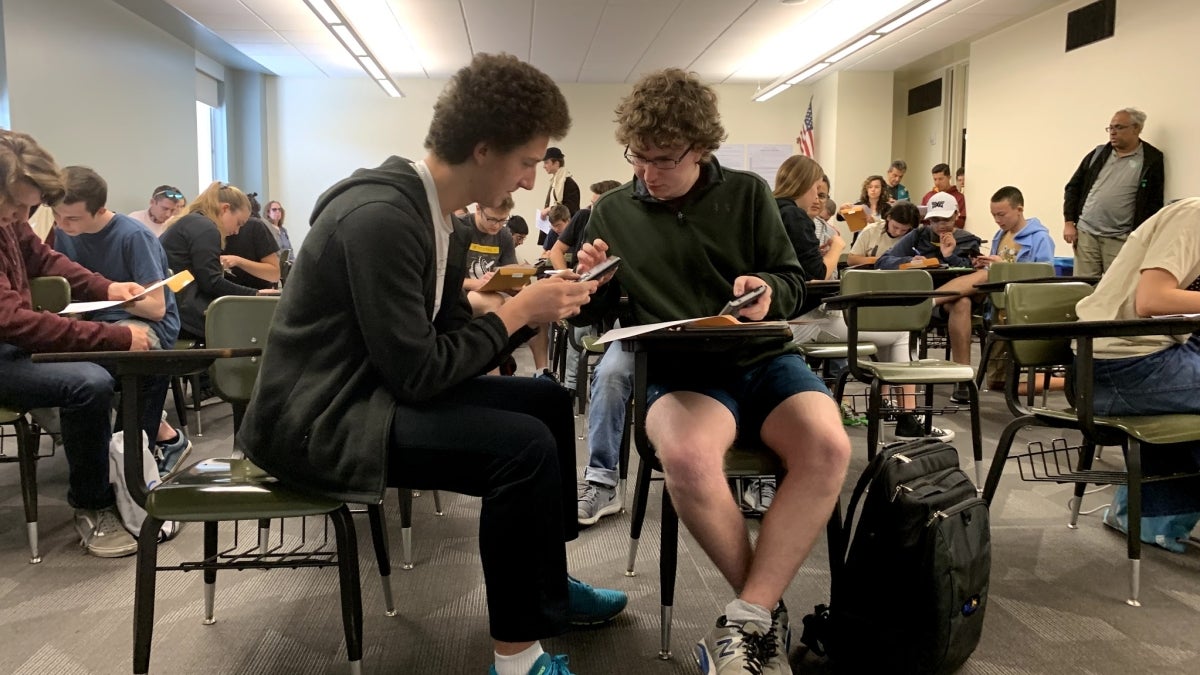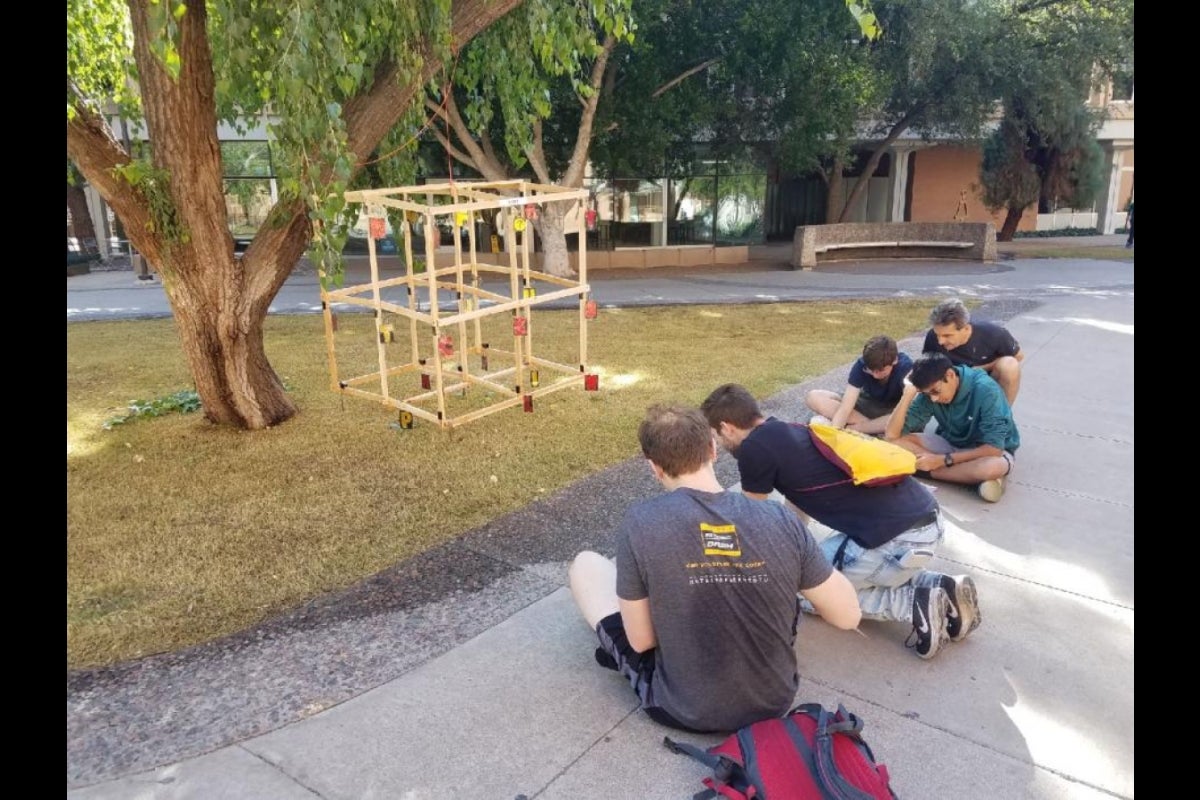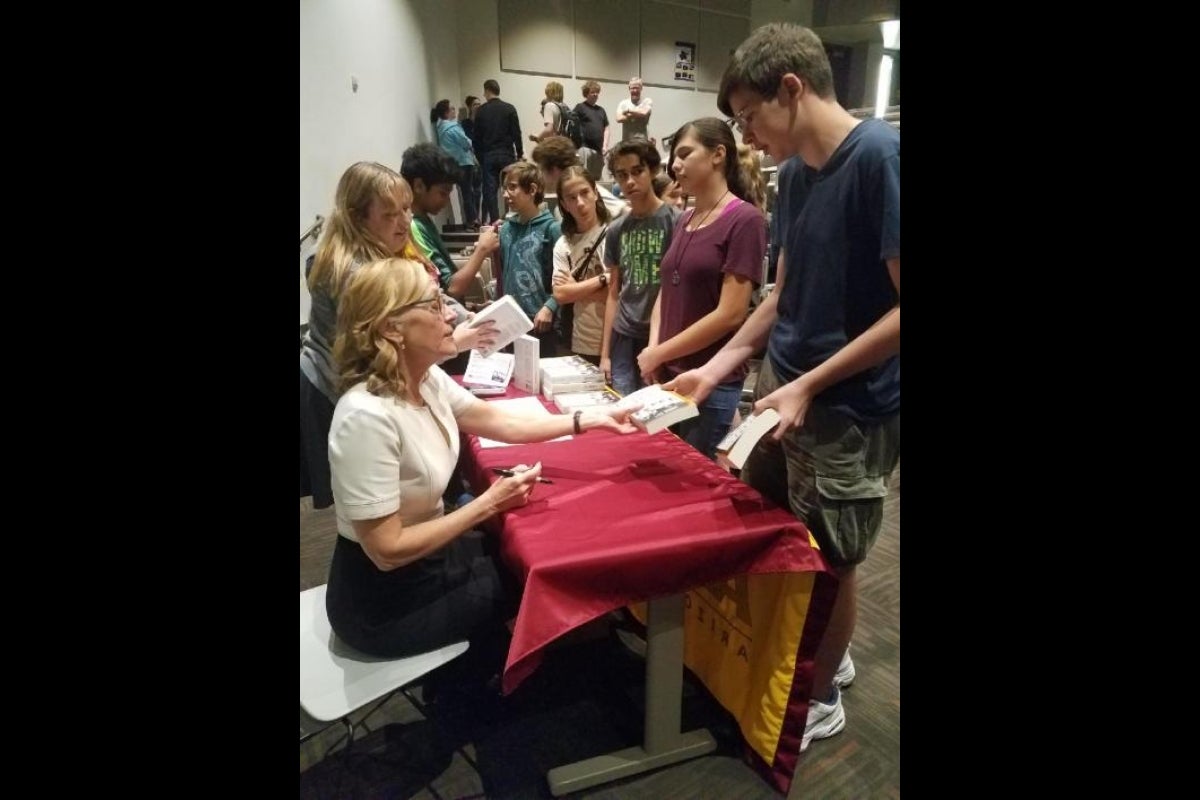High school students dominate ASU's Cryptorally cipher-solving competition

Brothers Walker and Griffin Kroubalkian work as a team to solve the first cipher of Cryptorally 2018.
Can you solve this cipher?
"tdehahrtmitehriiscm."
About 100 students arrived early on Saturday, Nov. 17, to try to do just that. They teamed up to compete in the eighth annual Cryptorally at Arizona State University.
Cryptorally is a cipher-solving scavenger hunt, hosted by the School of Mathematical and Statistical Sciences. Students at the university or high school level can compete solo or with a partner. They decrypt each cipher to reveal a clue that leads to a secret location on campus, where they receive their next cipher. Teams made their way around the ASU Tempe campus, starting at Wexler Hall and visiting places such as Hayden Library, the Memorial Union, Palo Verde East, Virginia G. Piper Writers House and the new Biodesign C building.
A total of 24 teams competed: 19 university teams and five from high schools. For the first time in the history of Cryptorally, all three winning teams were comprised of high school students. The first team to cross the finish line was University High School senior Walker Kroubalkian and his younger brother, Griffin, a freshman at Sabino High School, both in Tucson.
Coming in second place was the team of Logan Lu and Kishore Rajesh, and finishing third was Roshan Pillai and Raymond Nucuta, all high school sophomores at Basis Scottsdale.
This was the first win for Walker Kroubalkian, but he and another partner came in second place last year. He also competed as a sophomore the year before.
“Cryptorally has been a blast the last three years, and I hope to keep participating in it in the future,” Kroubalkian said.
“We were ecstatic to receive first place this year. To see all of our hard work pay off was a truly satisfying experience. Last year I finished in 2 hours and 50 minutes. This year we set the goal of shaving an hour off of that time, and we were thrilled when we found out we finished in roughly 1 hour and 27 minutes.”
The Cryptorally is designed by associate professor Nancy Childress, who teaches cryptography.
Cryptography is used to help protect sensitive information. Applications of cryptography include electronic commerce, chip-based payment cards, digital currencies, computer passwords and military communications. Modern cryptology relies on ideas from number theory, abstract algebra and discrete mathematics.
“It's wonderful to see growing participation by high school students, and impressive to see many of them do so well,” Childress said. “I hope the experience will reinforce their interest in mathematics!”
Again this year, Cryptorally included a Junior Rally division for middle school students who practiced their decoding skills during after-school math clubs. Fifteen teams participated from five different schools, including Connolly Middle School, Basis Scottsdale, St. Francis Xavier, Kyrene Del Pueblo and Odyssey Institute.
The Cryptorally event included a student research poster session, which was judged by mathematics professor Andrew Bremner and postdoctoral associate Evan Dummit. The author of the winning poster was Elliot Gorokhovsky, a sophomore mathematics major, who studied NFS factorization in heuristic expected time.
After lunch, Cryptorally participants, faculty, volunteers and visitors attended a featured talk by New York Times best-selling author Liza Mundy. She discussed her book, "Code Girls: The Untold Story of the American Women Code Breakers of World War II." Recruited by the U.S. Army and Navy from small towns and elite colleges, more than 10,000 women served as code breakers during World War II.
Mundy's presentation contained interesting historical photos of the code breakers, including Jacqueline Jenkins-Nye, mother of Bill Nye "The Science Guy." Jenkins-Nye was one of the scientifically accomplished young women recruited by the Navy to help crack the seemingly impenetrable codes used by the Japanese and German militaries during World War II. Their efforts shortened the war and saved many lives, but the women were sworn to secrecy, never allowed to speak about their work.
Mundy discovered recently declassified documents at the archives of the NSA, which allowed her to tell the incredible stories and accomplishments of these women. After the presentation, she took the time to personally sign books for the student winners.
Cryptorally champion Walker Kroubalkian answered some questions about the event.
Question: Was there anything in particular that you did to prepare for this year’s event that you think made the difference in your team winning?
Answer: I think the biggest part of our success was all of the preparation we did in reviewing all of the ciphers and practicing the process of breaking them with a calculator. One of our biggest challenges was navigating the beautiful ASU campus. My brother really helped us to not get lost while going from place to place. Another big part of our success was the programs we had prepared for our calculators that did most of the decryption for us.
Q: Which cipher did you like best, and why?
A: I think my favorite cipher on the day of the competition was the Trifid cipher. Its unique method of encrypting information with a key as complex as a 3x3x3 grid made it both intimidating and exciting to crack.
I also really enjoy the rail fence cipher as I think it is a great example of how a cipher that makes encryption simple and fun for the average person can be very effective at obscuring information. (Editor's note: The cipher at the top of this story is a rail fence cipher.)
Q: How would you describe the Cryptorally event to other high school students thinking about competing next year? Would you recommend it to others?
A: The Cryptorally event is one of the most entertaining activities I have participated in during high school. The idea of a thrilling scavenger hunt throughout the beautiful ASU campus that helps students to exercise their math and computer science skills is one of the most novel ideas I have ever heard of. In addition, I was very impressed by the guest speaker and best-selling author Liza Mundy, who gave a talk on the experiences of the women who were code breakers during World War II. I would absolutely recommend this event for anyone who is even remotely interested in the process of breaking codes.
My favorite part of the event was seeing the results of all the hard work we put into developing the programs for decrypting these codes. When we first saw the list of ciphers for the Cryptorally, we attempted to program functions that could decrypt each cipher in Python, the programming language that we were most familiar with. After finishing coding the solutions in Python, we converted all of our code into the TI-Nspire BASIC Programming Language. This process taught us a lot about programming on a calculator that we were not experienced with. After spending countless hours refining these programs, we were thrilled to see them successfully break codes at the ASU Cryptorally.
Q: What are your future plans after you graduate from high school?
A: I plan to major in engineering. I am not sure where I will go for college, but I was just accepted to ASU and Barrett, The Honors College and I am very excited about it.
And what about the answer to that cipher at the top? Just like this year’s Cryptorally winner, "third time is the charm."
More Science and technology

ASU professor wins NIH Director’s New Innovator Award for research linking gene function to brain structure
Life experiences alter us in many ways, including how we act and our mental and physical health. What we go through can even…

ASU postdoctoral researcher leads initiative to support graduate student mental health
Olivia Davis had firsthand experience with anxiety and OCD before she entered grad school. Then, during the pandemic and as a…

ASU graduate student researching interplay between family dynamics, ADHD
The symptoms of attention deficit hyperactivity disorder (ADHD) — which include daydreaming, making careless mistakes or taking…


